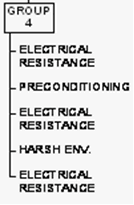Test Group 4: Let’s Not Be Too Harsh
Dr. Bob on Test Group 4: Let’s Not Be Too Harsh
Test group 4 of EIA364D includes testing in a harsh environment, or corrosion based on exposure. The complete generic test sequence for EIA 364D was shown in the first article in this series.
 Test group 4 calls out a “harsh environment,” and that description merits some commentary. There are two basic issues to be considered. First, harsh to what? And second, how harsh is harsh?
Test group 4 calls out a “harsh environment,” and that description merits some commentary. There are two basic issues to be considered. First, harsh to what? And second, how harsh is harsh?
The first issue is fundamental. Harsh refers to an exposure that has the potential to cause significant corrosion-related degradation to the materials of manufacture of a given connector system. In other words, the exposure must have the potential for activating corrosion-related degradation mechanisms intrinsic to the connector, in particular to the contact springs under evaluation. Connector degradation mechanisms were discussed in a previous series of articles for ConnectorSupplier.com. Different environments provide different driving forces for a variety of degradation mechanisms. In that degradation series, it was noted that corrosion-related degradation in noble metal, e.g. gold over nickel contact systems, results from corrosion of exposed copper of the connector contact springs, through bare edges, porosity, or plating wear. For tin-contact finish systems, the major corrosion degradation mechanism is fretting corrosion, a buildup of tin oxide debris in and around the contact interface, due to small displacements (a few to a few tens of microns) of the contact interface, which is due to thermally or mechanically driven motions. Such small scale motions are commonly referenced as fretting motions. The “corrosion” part of fretting corrosion is, of course, the creation of the oxide debris.
In test group 4, a mixed flowing gas exposure (EIA 364D, TP65) could be a harsh environment for a connector system using a noble metal, e.g. gold over nickel, contact finish, but would not be considered harsh for a tin-finished connector system. Conversely, some consider a humidity exposure (EIA364D, TP31) to be a harsh environment for tin-finished connector systems, but not for noble metal systems.
The second issue—how harsh is harsh?—is both fundamental and practical. From a fundamental viewpoint “harsh” could be interpreted as a test exposure that is highly likely to result in degrading mechanisms that could have a significant effect on some connector performance characteristic. In this case, contact resistance. Consider salt spray (EIA 364D, TP26). Salt spray is highly corrosive to many materials and has been demonstrated to cause failures in a variety of connector systems, both noble and non-noble. This observation raises the second part of this issue, practicality, or perhaps more importantly, relevance. Salt spray is so harsh that it can result in failures of connector systems that are perfectly suitable for their intended application environments. The issue with salt spray is more an assessment of the relevance of the test than the “harshness” of the test. Salt spray may be appropriate for connectors intended for a marine environment, but it is not appropriate for evaluating connectors intended, for example, desktop computer applications.
There is one more major “harshness” issue—the relationship between the degradation that takes place in the test environment compared to that occurring in the field environment the test is intended to simulate. As mentioned, mixed flowing gas (EIA 364D, TP65) is an appropriate exposure to simulate corrosion mechanisms of importance in noble metal connector systems. There are, however, different levels of harshness, or severity, in TP65, as indicated in the following table.
Mixed Flowing Gas
(Concentration – ppb*)
| Class II | Class III | |
| C12 | 10 ± 3 | 20 ± 5 |
| NO2 | 200 ± 50 | 200 ± 50 |
| H2S | 10 ± 5 | 100 ± 20 |
| SO2 (Optional) | 200 ± 20 | 200 ± 20 |
| Temperature | 30 ± 2°C | 30 ± 2°C |
| Humidity | 70 ± 2°C | 75 ± 2°C |
There are two things to note in the table above. First, the gas concentrations are measured in ppb, parts per billion. These are, of course, very low concentrations, and make the analysis and control of the gases a significant factor in carrying out the test exposures. Second, the gases that vary between the two levels are chlorine and hydrogen sulfide. The synergistic effect of these two gases in the environment is what controls the severity levels. While numerous investigators have studied and defined mixed flowing gas (MFG) exposure conditions, the data base most commonly used to establish a correlation between field degradation and that occurring during test exposures was developed by Battelle Laboratories in the ‘70s and ‘80s. From such data, Class II test exposures are intended to simulate an office or controlled field environment, and Class III exposures simulate industrial or uncontrolled environments. These MFG exposures are used in a variety of test and qualification specifications for evaluating the corrosion response of noble metal contact finishes.
Of equal importance to the correlation of field and test degradation is the fact that acceleration factors—relationships between field and test exposure durations—have been established for MFG exposures. The commonly applied acceleration factor indicates that two days in the appropriate test environment is roughly equivalent to one year in the field. No other corrosion test exposure has a commonly accepted acceleration factor associated with it. The importance of such an acceleration factor is that performance in the field over time can be evaluated. In fact, few test exposures of any type have a generally accepted acceleration factor. The importance of this statement will be revisited in a later article when I discuss test sequences to assess field performance and reliability.
In summary, the definition of harsh environment exposure requires consideration of several factors:
-
Selection of an appropriate test environment/exposure for the connector materials system under consideration. In general, this results in calling out mixed flowing gas (TP65) for noble metal finishes and humidity (TP31) for tin systems.
-
Selection of the appropriate severity level to simulate the intended application field environment.
-
Selection of the appropriate test duration to simulate the intended application lifetime in the field.
In the next article in this series, Max Peel, Senior Fellow of Contech Research, will discuss practical aspects of harsh environment testing practices.
- Nanocrystalline Silver Alloy Contact Finishes in Electronic Applications - April 6, 2015
- Nanocrystalline Silver Contact Platings - March 16, 2015
- Dr. Bob on Gold Flash Contact Finishes (and Max Peel) - September 22, 2014






